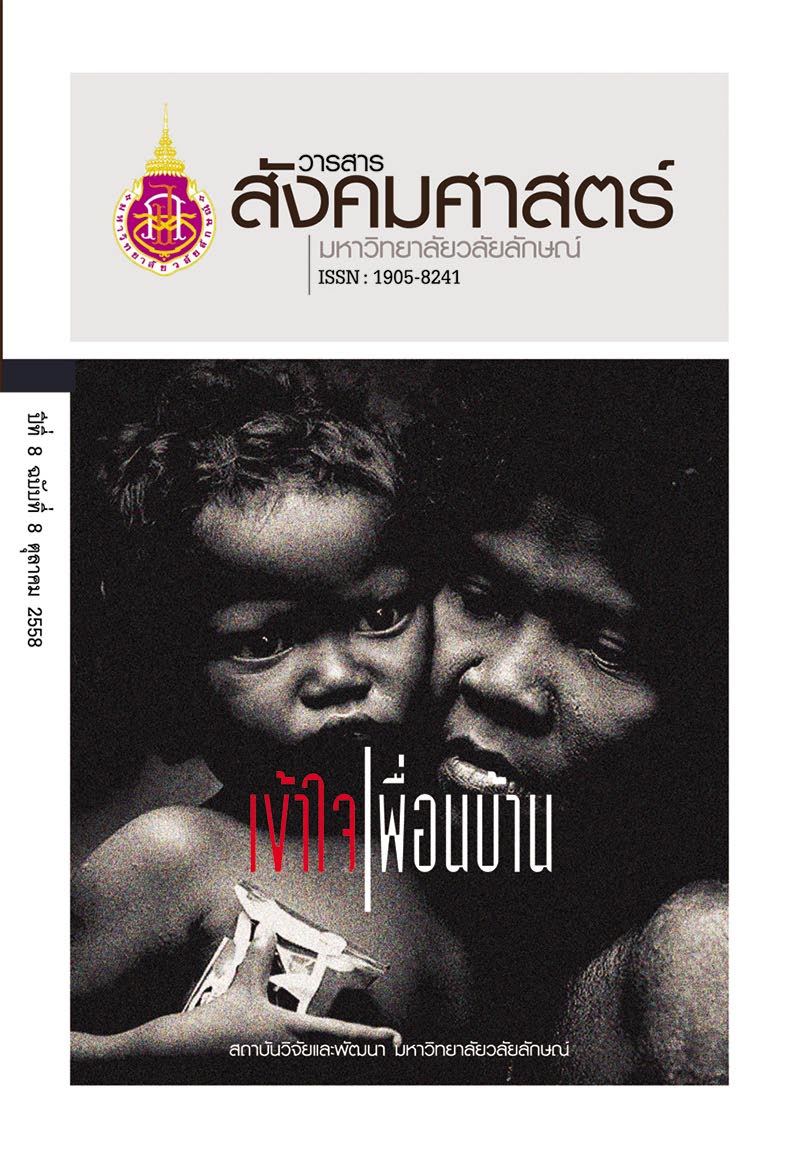Dikir Music: Condition, Development and Position in the entertainment world of Melayu Patani (in Thai)
Main Article Content
Abstract
This research article entitled “ Dikir Music: Condition, Development and Position in the entertainment world of Melayu Patani”. I want to describe conditions and development of the Dikir Music, and to posit it in the entertainment world of the Melayu culture in Patani. In order to positing the Dikir Music as a Melayu Patani popular music, I will employ the historical framework to handle the data from the music-records, published local materials, newspapers, and researches on cultural entertainment in the Deep South, including data from interviews during my fieldwork which consist of singers, lyrics-writer, musicians, entrepreneurs, recording studio and broadcasters of radio stations in the local as well.
The study found that the development of the Dikir Music has started in the late 1980s, and since then it became widely known among Melayu Patani audiences. Originally, the Dikir Music was situated within the soundscape of traditional performance known as the Dikir Hulu. In order to record the solo-performance of the leading-vocalist of the troupe, the Dikir Music was taking shape. It was no longer a solo-singing of the leading Tukang Karut vocalist per se. It began to employ other popular musical instruments and melodies such as Indian film songs, Thai popular music, and Indonesian popular music. Gradually, it became a singing performance by its own style, in a new soundscape and perhaps new audiences. As a result of the decentralization of local recording industry and the support of local entrepreneurs, it can be said that the Dikir Music was emerged in a popular music form, manufactured in mass production such as Cassette, CDs and VCDs. Arguably, the Dikir Music is truly the modern Melayu Patani entertainment among traditional cultures and cultural flows in the Melayu Patani world.
เพลงดิเกร์มิวสิค: เงื่อนไขปัจจัย พัฒนาการ และตำแหน่งแห่งที่ในโลกความบันเทิง มลายูปาตานี
บทความวิจัยเรื่อง “เพลงดิเกร์มิวสิค : เงื่อนไขปัจจัย พัฒนาการ และตำาแหน่งแห่งที่ใน โลกความบันเทิงมลายูปาตานี” นี้ ผู้วิจัยต้องการ อธิบายเงื่อนไขปัจจัยและพัฒนาการของเพลง ดิเกร์มิวสิค รวมทั้งจัดวางตำาแหน่งแห่งที่เพลง ดิเกร์มิวสิคในโลกของวัฒนธรรมความบันเทิง มลายูในปาตานี ในการอธิบายเงื่อนไขปัจจัยและ จัดวางเพลงดิเกร์มิวสิคในฐานะดนตรีสมัยนิยม มลายูปาตานีนั้น ผู้วิจัยจะใช้กรอบคิดทาง ประวัติศาสตร์เพื่อวิเคราะห์ข้อมูลจากการบันทึก เสียงดนตรี เอกสารในท้องถิ่น หนังสือพิมพ์และ งานวิจัย เกี่ยวกับวัฒนธรรมความบันเทิงในพื้นที่ จังหวัดชายแดนภาคใต้ ตลอดจนข้อมูลจากการ สัมภาษณ์ในภาคสนามอันประกอบด้วยนักร้อง นักแต่งเพลง นักดนตรี ผู้ประกอบการ สตูดิโอ บันทึกเสียง และผู้จัดรายการวิทยุในท้องถิ่นอีกด้วย
จากการศึกษา พบว่าพัฒนาการของเพลงดิเกร์มิวสิคได้เริ่มต้น ขึ้นตั้งแต่ช่วงปลายทศวรรษ 2520 แต่แรกเริ่มนั้นเพลงดิเกร์มิวสิคดำรง อยู่ในภูมิทัศน์ที่สร้างโดยเสียง (soundscape) ของการแสดงพื้นบ้าน ดิเกร์ฮูลู เพื่อที่จะบันทึกเสียงของนักร้องนำหรือตูแกกาโระของคณะ ดิเกร์ฮูลู และในที่สุดเพลงดิเกร์มิวสิคก็ก่อกำเนิดขึ้น เพลงดิเกร์มิวสิค นั้นเป็นการนำเอาเครื่องดนตรีสมัยใหม่และหยิบยืมจังหวะทำนองจาก ที่ต่าง ๆ เช่น เพลงภาพยนตร์อินเดีย เพลงสมัยนิยมไทย และเพลงสมัย นิยมอินโดนีเซีย เป็นต้น หลังจากนั้นก็ค่อย ๆ กลายเป็นการขับร้องเฉพาะ เพลง อันมีรูปแบบที่เฉพาะตัวแบบใหม่และผู้ฟังใหม่ ๆ ทั้งนี้ผลของการ กระจายตัวของอุตสาหกรรมการบันทึกเสียง และการสนับสนุนของ นายทุนท้องถิ่น ทำให้เพลงดิเกร์มิวสิคกำเนิดขึ้นในฐานะรูปแบบดนตรี สมัยนิยม (popular music) และถูกผลิตออกมาในรูปแบบผลิตภัณฑ์ มวลชน เช่น เทปคาสเซ็ท (cassette tape) ซีดี (CDs) และวีซีดี (VCDs) เป็นต้น กล่าวได้ว่า เพลงดิเกร์มิวสิคคือวัฒนธรรมความบันเทิง มลายูปาตานีแบบสมัยใหม่อย่างแท้จริง
Article Details
Copyright: CC BY-NC-ND 4.0


